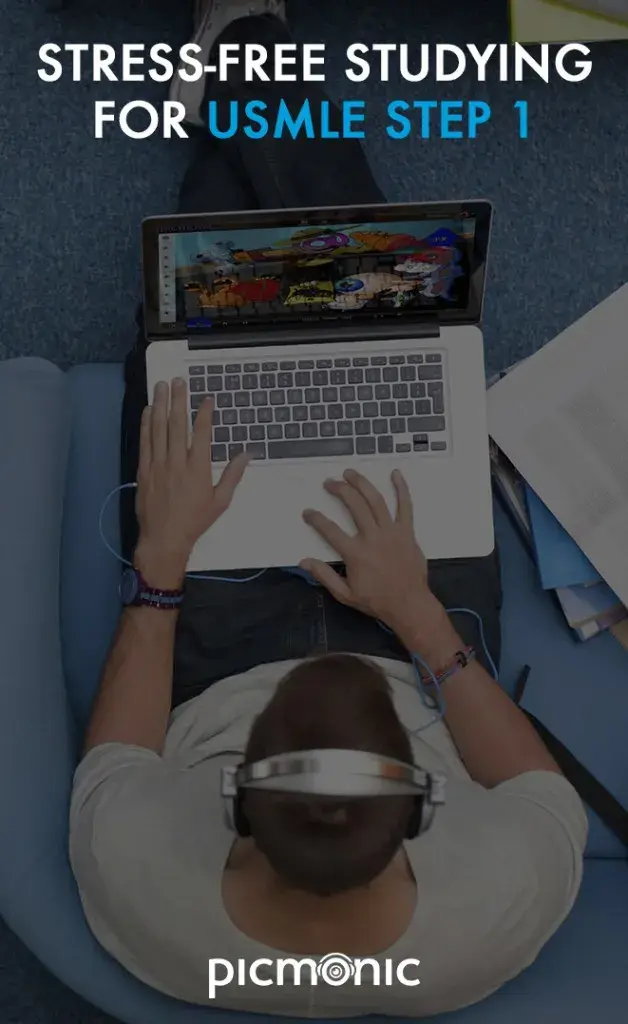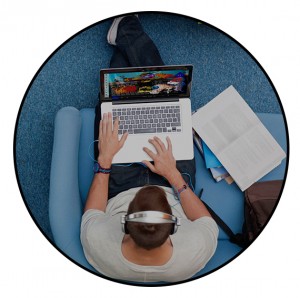
Everyone has superstitions when it comes to studying, especially med students who have everything riding on the USMLE Step 1 exam.
There’s that guy who swears he studies best while blasting music, while someone else requires perfect silence. Or your other classmate who has A/B tested her study habits and concluded she must study between 2 and 8 p.m. to retain more than 75% of the material.
Regardless, there are a few study practices that work for nearly everyone, and we’ve compiled them for you. In this article, we will dive into some valuable tips and tricks from successful test takers to help you not only pass but excel on the USMLE Step 1.
Tips for Setting Up Your Study Space at Home
If you ever feel like you could study better in a zoo than at home, this one’s for you! Your roommates bug you, your phone is always going off, the dishes need washed, the laundry needs done, you’re hungry again and the kitchen’s right there…is this a familiar refrain?
If you find it hard to focus at home, the following tips will help you become a study at home champion. Sure the dishes might sit in the sink an extra day and you might have to wear that shirt for a second time, but at least you’ll pass the USMLE!
1. Create a space

The best thing about the library is there is no bed for napping. When you’re there, your options are dictated by the environment of tables, computers and books. You can read, write and study – or do all three at once if you’re a show-off. At home, you must create a work space that gives the same options.
Set up a serious work space, and designate it only for studying.
That may mean converting the kitchen table to your study zone by clearing it of all familiar objects and setting up your books, a picture that reminds you of why you’re in med school and all the materials you’ll need for studying (ahem, Picmonic). Or partition off a part of your room with a curtain that you can close when you’re not studying. If you have the benefit of an office, retire to this room to study and shut the door. It becomes a separate place from the rest of your house. When you’re done, leave and shut the door again, turning the rest of your pad back into a living space.
2. Set your office hours
Many students study each day until their brain or body gives out. Picture someone wandering the desert until collapsing from dehydration…not exactly an image that elicits a thirst for studying.
The more you dread studying, the more distractions seem to pop up, especially when you’re studying from home. Suddenly emptying the dishwasher, alphabetizing your movies and matching all the missing socks becomes an immediate priority.
Instead, set a study time period that perhaps culminates in a reward, and your brain immediately focuses on the end result of finishing. Respect those hours. If you say you’re studying for four hours, stop at four hours no matter what. You’ll return for the next study session refreshed.
3. Put up boundaries
Do you have roommates who can’t comprehend why you’re always hitting the books? Does your mother have a Spidey sense for calling right when you’re tackling a particularly complex disease description? You must set expectations for the people in your life so they can respect your busy schedule and yet still maintain a relationship with you.
Once you’ve set them, let other people know your study hours. If, from 4 to 7 p.m. you’re studying, then people know not to text, call, Snapchat or otherwise distract you during those hours. Even if you’re in the common area of your apartment, suggest your roommate pretend you’re invisible during those hours. Implement this, and you’ll both value the non-study hours even more!
4. Change your scenery
There will be days when none of the tips above work, when you feel like you’re on a death march as you approach your books. So change it up. Go to your favorite coffee shop or a park or a med school buddy’s house. Changing your scenery will feel like a mini vacation and recharge your brain for more studying.
If you want to change the scenery entirely, join Picmonic and set aside those cumbersome books and pages of chicken scratch notes. Every slide in Picmonic takes you to a new world of picture and sound-based mnemonic devices where you almost effortlessly learn what you need to know to pass your exams.
Ways to Recharge your Posture
Maintaining proper posture while studying is crucial for both physical health and cognitive performance. Good posture promotes comfort and can enhance concentration and overall productivity, leading to more effective and efficient learning.
1. Sit up and listen

You pass by a mirror and, for a second, think someone’s following you. Who is that hunchbacked person shuffling along with their nose in a medical book? Oh right, that’s you.
The pursuit of your passion often means studying for long hours and may take a toll on your sleep, your eating and your posture.
Your mother always told you to sit up straight, but she’s isn’t around for your marathon study sessions. And if you’re going to dedicate mental fortitude to something, it’s probably going to be to memorizing the differences between antiarrhythmics in cardiac pharmacology for your USMLE Step 1, not making sure your posture is perfect the whole time.
But poor posture leads to a whole slew of aches and conditions you don’t want, and improved posture is possible in a few easy steps. First, give yourself a reality check by assessing your posture, then follow our straight-up advice.
2. Ditch the armchair and belly up to a table
Set yourself up for success, beginning with the kind of chair you sit in. Do you study on the couch or in an armchair, curled awkwardly around your books or with your laptop in your lap? We get it, it’s called a laptop – but that doesn’t mean that’s where you should always have it. It’s too easy to slouch in a comfy chair or hunch while staring down at the computer sitting on your knees.
Instead, sit in a firm, high-backed backed chair and place your study materials on a table in front of you. Scoot your hips against the back of the chair and then do your best to keep your back pressed against it as well. If you’re struggling to align with the chair’s back, you may place a small pillow or rolled towel behind your lower back to support it. Make sure your hips are at knee level or a little below.
3. Watch where you put your feet
Now that you’re in the high-backed chair, the first thing you search for is something to prop your feet on. Break this habit! It inevitably leads to your hips and lower back sagging away from the chair. Plant your feet on the floor, and kick-start good posture from the ground up.
4. Take deep breaths
As you continue to sit and study for long periods of time, your body caves in on your anterior side. Because of this, you tend to take shallower breaths, which can contribute to an overall weariness.
Breathe in slowly through your nose, fill your belly with air and hold it for a two count. Then release and repeat two more times. The fresh and full breath will energize you. Toss in a little backbend on the inhale, and your whole torso will thank you.
5. Shake what ya Mama gave ya
The human body is designed to be in motion. Your body is trying to tell you this when you develop that annoying crick in your neck or your butt goes numb from sitting. So once an hour, get up, put on your favorite song and dance, dance, dance. If you have limited space, sitting works too. Or every other hour, take a 15-minute break to do posture-perfecting poses.
6. Cut down your study time
Of course, you could just cut down your study time by studying with Picmonic. Research shows Picmonic’s audiovisual mnemonic methodology helps students master information faster and retain knowledge longer.
USMLE Step 1 Tips and Tricks for Success

Studying for USMLE Step 1 can be brutal. Don’t let it suck away all of your joy. Here’s our Picmonic-endorsed 5-step plan to increase your chances of getting a strong score on this crucial exam.
1. Test Day Due Diligence
You don’t want any surprises on test day. Check your Step 1 permit and make sure everything looks right, and that the name on it matches your ID exactly. Then, double check your registration on Prometric. Maybe triple check it, just to be safe. Then, figure out what your transportation time will be to get there. Give yourself a cushion of about 45 minutes, just to be safe.
If you’re traveling far for your test, double check all of your flight and hotel info, and make sure you have a good time cushion in case of a flight delay. If possible, visit where you’ll be taking the test to get a little more comfortable with your surroundings.
2. Practice Makes Perfect
If you have enough time before your test, apply for a USMLE Step 1 Practice Permit. This will let you practice taking an actual test in the location where you’ll be taking the real thing eventually, which can be a great help mentally. If you don’t have time, or that’s not an option because of travel time, don’t worry! There’s still plenty you can do. Write at least one NBME to help you figure out where your weaknesses lie and how long the test might take you.
3. Work on Your Weaknesses
Now that you’ve written an NBME for practice, use that to help you assess your weaknesses. To get them up to snuff before you take Step 1, use your study resources – including Picmonic! The Picmonic Learning System has been proven to help increase information retention, and it can help you take out your weaknesses one at a time.
4. Relax and get some sleep
This one might seem impossible, but relax! Make yourself a schedule, and make sure that you’re giving yourself breaks to avoid burnout while studying for Step 1. Everything in life is also easier to face after a good night of rest. If you can’t get rest, good coffee is a shortcut to getting happy; just don’t make a habit out of replacing sleep with caffeine.
5. Do the Darn Thing
The only thing left is to do it! Go into it with a realistic yet hopeful attitude, and you will get the Step 1 score you’ve worked for. We believe in you!
Incorporating these proven USMLE Step 1 tips and tricks into your study regimen can significantly bolster you chances of success. Picmonic can also be your ally on the journey to achieving success on the USMLE. Give it a try!













